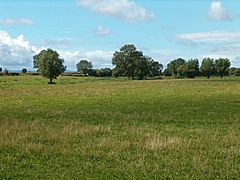Greylake facts for kids
| Site of Special Scientific Interest | |
 |
|
| Area of Search | Somerset |
|---|---|
| Coordinates | 51°05′54″N 2°52′52″W / 51.09838°N 2.88109°W |
| Interest | Geological |
| Area | 9.3 hectares (0.093 km2; 0.036 sq mi) |
| Notification | 1987 |
Greylake is a very special place in Somerset, England. It covers about 9.3 hectares, which is like 13 football fields! This area was officially recognized in 1987 as a Site of Special Scientific Interest (SSSI) because of its unique geology and amazing wildlife.
Contents
Discover Greylake: A Special Place in Somerset
Greylake is located on the Somerset Levels, a large area of flat, low-lying land. It includes 20 fields in the northwest part of King's Sedgemoor. Part of Greylake is now a Royal Society for the Protection of Birds (RSPB) nature reserve. This reserve used to be farmland, but now it's a safe home for many different birds and animals.
Amazing Wildlife at Greylake
The RSPB Greylake nature reserve is a fantastic spot for birdwatching. Many birds come here to live, feed, and raise their young. You might see:
- Northern lapwings, with their cool crests.
- Common snipe, known for their long beaks.
- Eurasian curlews, with their distinctive calls.
- Common redshanks, with their bright red legs.
- Western yellow wagtails, small birds with yellow feathers.
- Eurasian skylarks, famous for singing high in the sky.
- Meadow pipits, another type of small songbird.
A Peek into Earth's Past: The Burtle Beds
Greylake is very important for understanding Earth's history. It's known as the "type section" for something called the Pleistocene Burtle Beds. The Pleistocene was a period of time often called the "Ice Age."
The Burtle Beds are layers of ancient soil and rock. At Greylake, you can see a very complete sequence of these layers. They show how the area changed over thousands of years:
- First, there were fluvial gravels. These were left behind by ancient rivers, or possibly even glaciers.
- Next, there are marine intertidal silts. These are muddy layers that were once covered and uncovered by ocean tides.
- Finally, there are marine subtidal layers. These were formed underwater, never exposed by the tides.
Scientists have found many fossils in these beds. They include tiny creatures like molluscs (snails and clams), ostracods (tiny crustaceans), and foraminifera (tiny single-celcelled organisms). They've also found bones from larger animals that lived during the Ice Age, such as:
- Red deer (Cervus elephus)
- Aurochs (Bos primigenius), which were huge wild cattle.
- Fallow deer (Dama dama)
Flooding in 2013-14
Greylake, like much of the Somerset Levels, experienced significant flooding during the winter of 2013–14. This event showed how the landscape can be affected by heavy rainfall.

